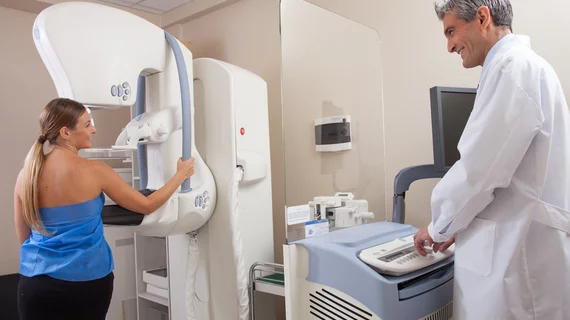3 takeaways from a new survey of women undergoing mammography
A team of researchers surveyed more than 2,500 women before they underwent screening mammography, asking them about anxiety, how often they think about breast cancer and more. The authors, sharing their findings in the Journal of the American College of Radiology, noted the results could help influence shared decision-making related to breast cancer and breast cancer screening.
The researchers received responses from 2,747 women from five different breast imaging facilities. All surveys occurred between Sept. 1, 2016, and March 31, 2017. More than 51 percent of respondents had no major known breast cancer risk factors, and more than 78 percent had no personal history of breast cancer.
These are three key takeaways from the team’s study:
1. Thinking about breast cancer more frequently was associated with certain factors
While women reported thinking about breast cancer a mean of 2.5 ± 6.6 times per month and a median of once per month, increased thoughts of cancer were significantly associated with a previous cancer diagnosis, the patient’s level of education, a family history of cancer, baseline anxiety, age and a history of high-risk biopsy.
“For breast cancer screening, shared decision making requires providers to be aware of potential objective, patient-related risk factors (eg, strong family history, BRCA mutation),” wrote author Lars J. Grimm, MD, MHS, department of radiology at Duke University Medical Center in Durham, North Carolina, and colleagues. “Providers must also have an understanding of patients’ personal perceptions and attitudes about their own breast cancer risk which are known to influence screening behaviors.”
2. Women with no known risk factors still have breast cancer on their mind
Twenty-three percent of women with no known risk factors think about breast cancer two to four times per month, and eight percent think about it at least four times per month.
“Because increased cancer worry can lead to counterproductive behaviors, women with increased cancer thoughts who present for screening mammography should be identified in radiology clinics so they can be encouraged to either maintain or improve their screening adherence,” the authors wrote. “Furthermore, outreach efforts to referring clinics are needed to identify women who infrequently or never undergo screening mammography to identify if cancer worry is the primary cause of their noncompliance.”
3. Breast cancer risk perception correlates with race
Among women with no breast cancer risk factors, classifying 10.2 percent and 16.7 percent of respondents still considered themselves as being at an intermediate or high risk, respectively. Such a finding was associated with higher baseline anxiety and being white.
In addition, black women provided “statistically significant lower” breast cancer risk estimates than white women, even when focusing specifically on women without any additional risk factors.
“Although white women may be overestimating their risk to some degree in this study, the large racial gap in risk perception suggests that black women are also underestimating their own risk, which may in turn be contributing to the worse clinical outcomes and decreased utilization of screening mammography,” the authors wrote. “As a result, improved educational outreach efforts directed toward black women to improve knowledge of the racial differences in breast cancer outcomes and the subsequent importance of breast cancer screening are likely indicated.”
Overall, the team concluded, referring providers and radiologists should keep these findings in mind as they “could help improve shared decision making for breast cancer screening and potentially help reduce patient anxiety and improve breast cancer screening compliance.”

